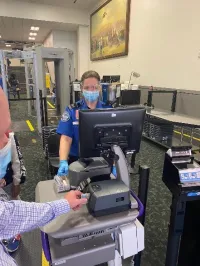 Computed Tomography scanner in checkpoint at Bozeman-Yellowstone International Airport
Computed Tomography scanner in checkpoint at Bozeman-Yellowstone International Airport
BOZEMAN, Mont. – As the Thanksgiving holiday travel period approaches, the Transportation Security Administration (TSA) provided an overview of new technology and modified screening procedures that are in place at security checkpoints in Montana.
TSA is using computed tomography (CT) scanners in the security checkpoints at Bozeman-Yellowstone International Airport and Billings Logan International Airport (BIL). The scanners utilize state-of-the art technology and improve the ability of security screening officers to detect items inside carry-on luggage that are potential security threats.
The CT scanner applies a sophisticated algorithm during the screening process while an X-ray camera shoots hundreds of images while spinning around the conveyor belt, generating a 3-D image of the item being screened. The image can be manipulated on screen to allow for a better view of the bag’s contents so security officers can clear the contents of the bag without having to open it. Reducing the number of bag checks is beneficial since it reduces potential touchpoints amid the coronavirus pandemic. When the CT is in use, travelers do not need to remove electronics or travel-size liquids from carry-on luggage.
At BIL, TSA began using Credential Authentication Technology (CAT) in early October. CAT units are able to confirm the validity of a traveler’s photo identification and confirm flight information in near real time. When travelers approach the travel document checking podium and CAT is in use, they can insert or scan their own photo identification. This self-service opportunity eliminates the need to hand over a boarding pass or photo ID to the security officer, reducing potential cross-contamination. CAT units are also able to identify fraudulent documents and those that have been tampered with.
In addition to the use of technology, TSA has modified its procedures at airports across the country as part of its “Stay Healthy. Stay Secure.” campaign. Travelers departing any airport in Montana can expect to see:
- All security officers wearing face masks and gloves during the screening process. If a security officer is working in close proximity to travelers, they are also required to wear eye protection or a face shield. Security officers will change their gloves after each screening position rotation, after a pat-down or upon a passenger’s request
- Reduced physical contact due to the installation of acrylic barriers that limit exposure between security officers and travelers.
- Social distancing leading up to and in the security checkpoint environment.
- Increased frequency and intensity of cleaning and disinfecting surfaces in the security checkpoint including bins. This is no substitute for practicing good hygiene while traveling. Travelers are encouraged to wash their hands before and after going through the checkpoint.
Additional tips for traveling this holiday season include:
Step 1: Pack smart
Travelers should be aware of the contents of their carry-on bags and make sure they are not bringing prohibited items to the security checkpoint. To determine whether an item is allowed or prohibited in carry-on luggage, download the MyTSA app and use the “Can I Bring?” feature. By planning ahead, travelers can avoid a bag check and reduce the potential for cross-contamination.
Step 2: Wear a mask
TSA strongly recommends all travelers wear a face covering throughout the entire travel experience. Travelers may be asked to adjust their mask for ID verification or if it alarms during the security screening process. If a traveler does not have a mask and they require a pat-down, a security officer will provide a mask.
Step 3: Secure items in your carry-on
When removing items from pockets such as phones, keys, lip balm, tissues and loose change, travelers should secure those items into their carry-on bags instead of placing them in bins. Bins are a common use item and travelers should use caution when placing personal items in them.
Step 4: Traveling with food
In general screening lanes, food items should be packed in a clear plastic bag and placed in a bin for screening. This simple step further reduces the potential for cross-contamination and avoids having food sit directly in bins. If you are planning to travel with special foods to contribute to a Thanksgiving meal, be sure you follow this simple rule to ensure your food can travel with you: If you can spill it, spread it, spray it, pump it or pour it, pack it in a checked bag. For example, cranberry sauce, gravy and wine in quantities larger than 100 ml or 3.4 ounces should go in a checked bag. Cakes, pies and casseroles can travel in carry-on luggage.
Step 5: Traveling with hand sanitizer
TSA is currently allowing one oversized liquid hand sanitizer container, up to 12 ounces per passenger, in carry-on bags. Please remove the hand sanitizer from the carry-on bag and place it in a bin for screening. Passengers may also bring hand wipes of any size or quantity through security checkpoints.

